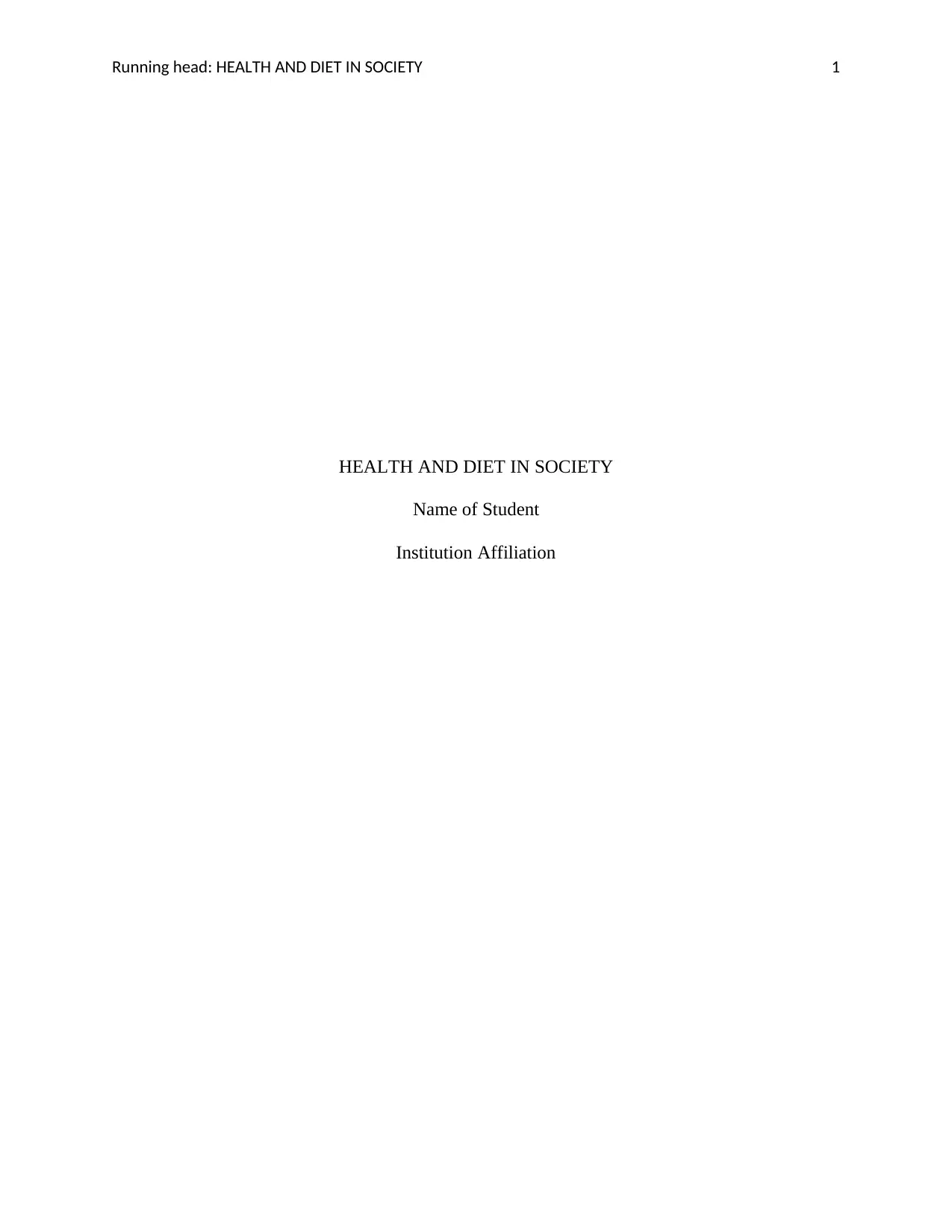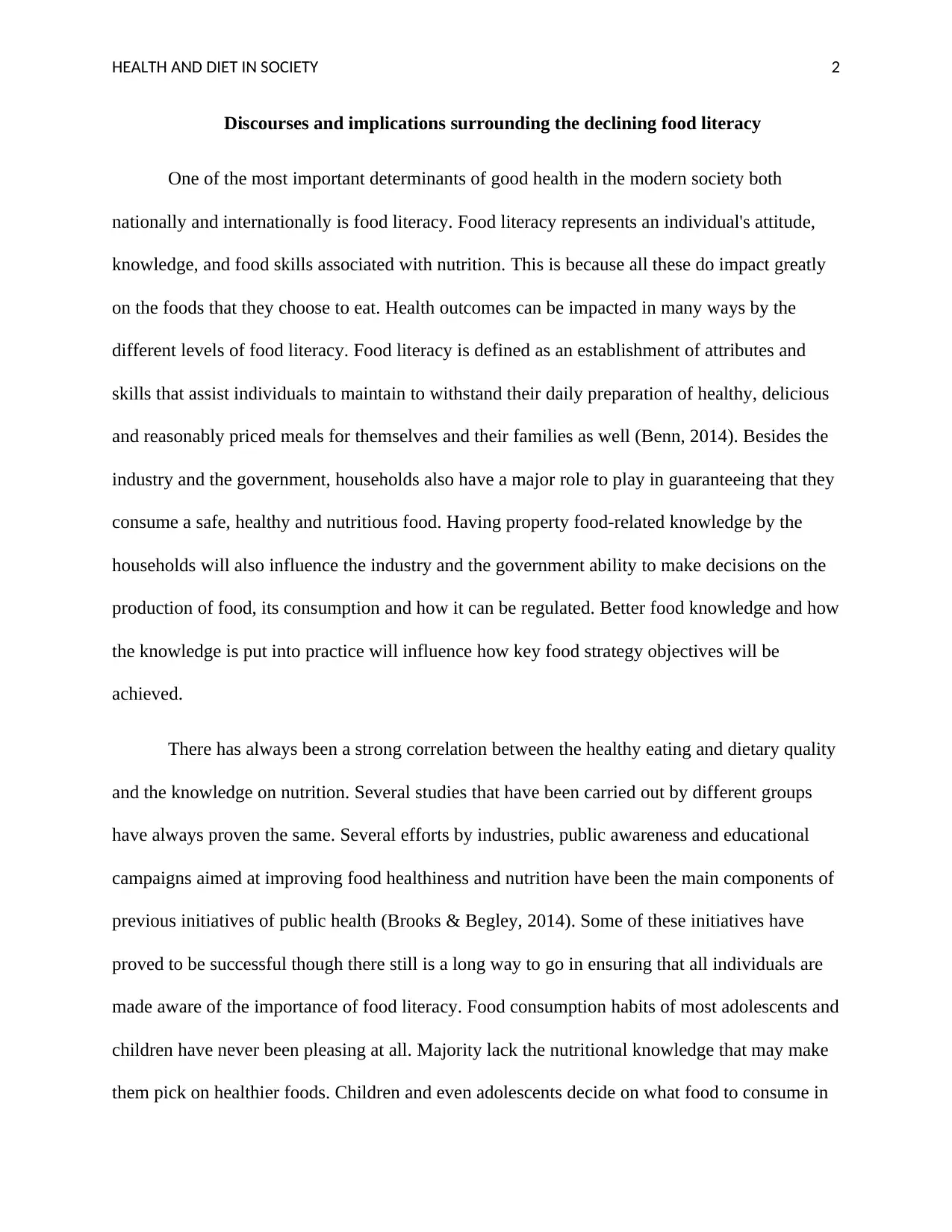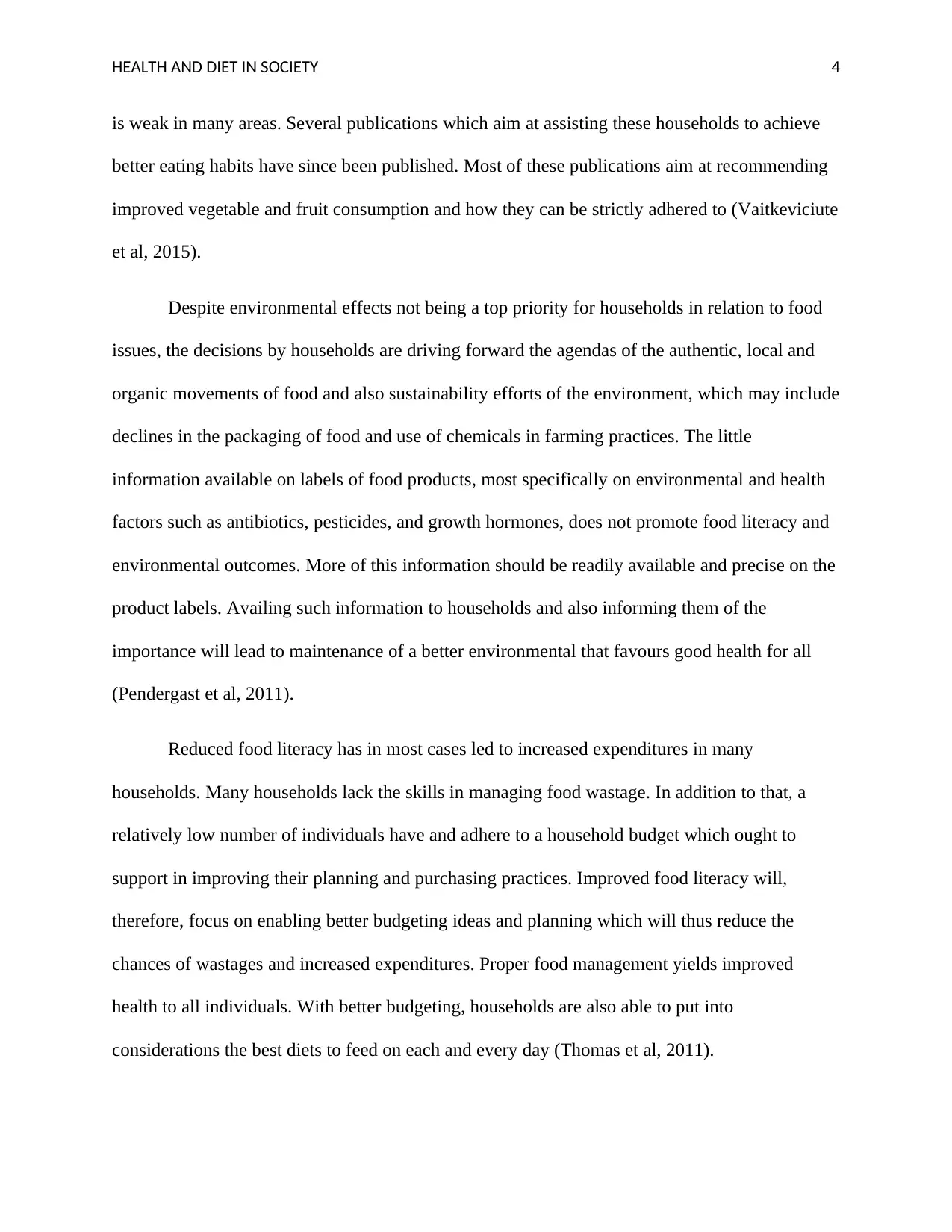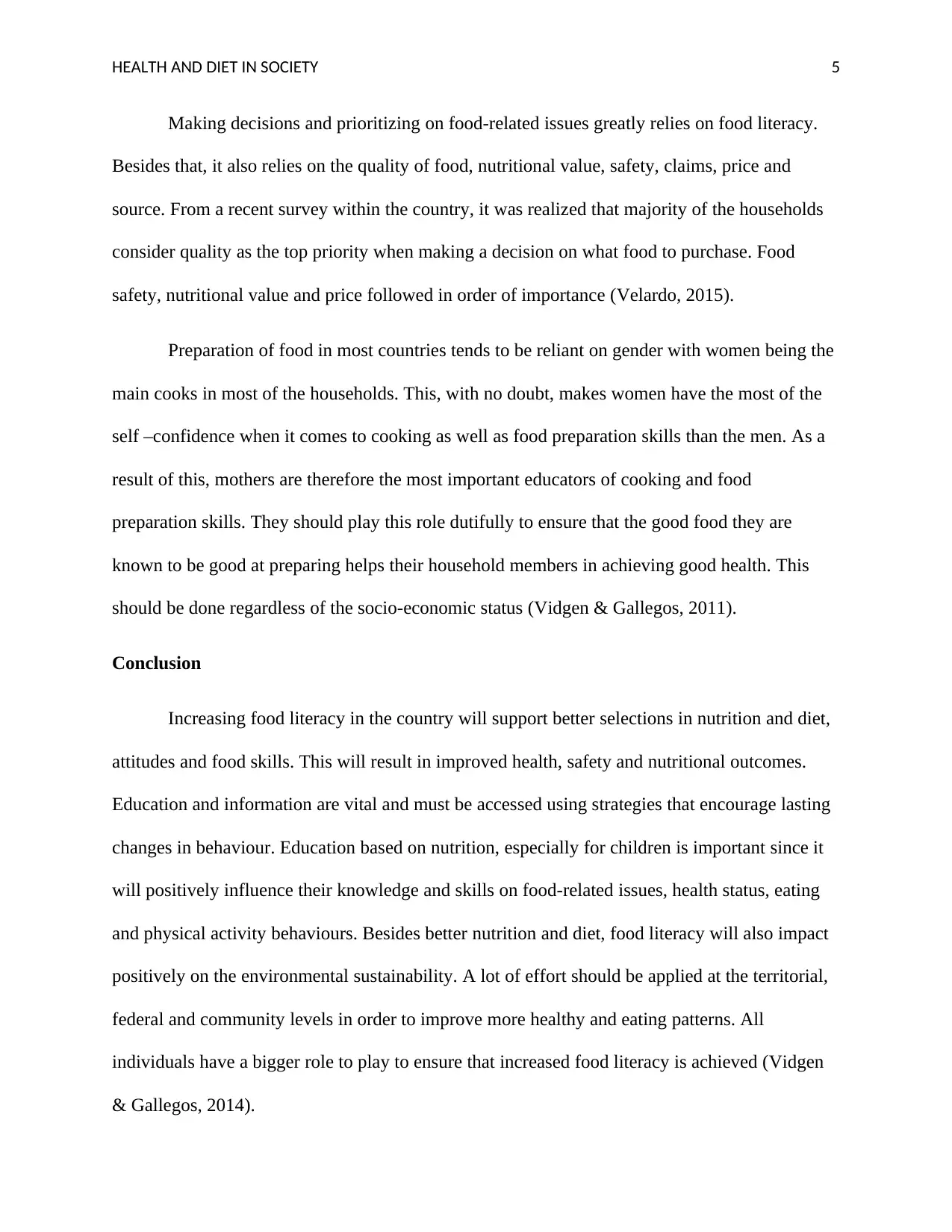Exploring Declining Food Literacy: Discourses and Implications Essay
VerifiedAdded on 2023/06/12
|6
|1814
|400
Essay
AI Summary
This essay delves into the discourses and implications surrounding the declining food literacy in modern society, emphasizing its significance as a determinant of good health. It highlights the importance of an individual's attitude, knowledge, and food skills related to nutrition and how these factors influence food choices and health outcomes. The essay discusses the roles of households, industries, and governments in ensuring safe, healthy, and nutritious food consumption. It addresses the correlation between healthy eating, dietary quality, and nutritional knowledge, pointing out the concerning food consumption habits of adolescents and the role of parents in shaping food literacy. Furthermore, it examines how food illiteracy can lead to poor dietary choices, increased expenditures, and environmental impacts, while emphasizing the need for improved food management, budgeting, and prioritizing food-related issues. The essay concludes that increasing food literacy supports better nutrition, diet, attitudes, and food skills, resulting in improved health, safety, and nutritional outcomes, and advocates for education and information strategies that encourage lasting behavioral changes.

Running head: HEALTH AND DIET IN SOCIETY 1
HEALTH AND DIET IN SOCIETY
Name of Student
Institution Affiliation
HEALTH AND DIET IN SOCIETY
Name of Student
Institution Affiliation
Paraphrase This Document
Need a fresh take? Get an instant paraphrase of this document with our AI Paraphraser

HEALTH AND DIET IN SOCIETY 2
Discourses and implications surrounding the declining food literacy
One of the most important determinants of good health in the modern society both
nationally and internationally is food literacy. Food literacy represents an individual's attitude,
knowledge, and food skills associated with nutrition. This is because all these do impact greatly
on the foods that they choose to eat. Health outcomes can be impacted in many ways by the
different levels of food literacy. Food literacy is defined as an establishment of attributes and
skills that assist individuals to maintain to withstand their daily preparation of healthy, delicious
and reasonably priced meals for themselves and their families as well (Benn, 2014). Besides the
industry and the government, households also have a major role to play in guaranteeing that they
consume a safe, healthy and nutritious food. Having property food-related knowledge by the
households will also influence the industry and the government ability to make decisions on the
production of food, its consumption and how it can be regulated. Better food knowledge and how
the knowledge is put into practice will influence how key food strategy objectives will be
achieved.
There has always been a strong correlation between the healthy eating and dietary quality
and the knowledge on nutrition. Several studies that have been carried out by different groups
have always proven the same. Several efforts by industries, public awareness and educational
campaigns aimed at improving food healthiness and nutrition have been the main components of
previous initiatives of public health (Brooks & Begley, 2014). Some of these initiatives have
proved to be successful though there still is a long way to go in ensuring that all individuals are
made aware of the importance of food literacy. Food consumption habits of most adolescents and
children have never been pleasing at all. Majority lack the nutritional knowledge that may make
them pick on healthier foods. Children and even adolescents decide on what food to consume in
Discourses and implications surrounding the declining food literacy
One of the most important determinants of good health in the modern society both
nationally and internationally is food literacy. Food literacy represents an individual's attitude,
knowledge, and food skills associated with nutrition. This is because all these do impact greatly
on the foods that they choose to eat. Health outcomes can be impacted in many ways by the
different levels of food literacy. Food literacy is defined as an establishment of attributes and
skills that assist individuals to maintain to withstand their daily preparation of healthy, delicious
and reasonably priced meals for themselves and their families as well (Benn, 2014). Besides the
industry and the government, households also have a major role to play in guaranteeing that they
consume a safe, healthy and nutritious food. Having property food-related knowledge by the
households will also influence the industry and the government ability to make decisions on the
production of food, its consumption and how it can be regulated. Better food knowledge and how
the knowledge is put into practice will influence how key food strategy objectives will be
achieved.
There has always been a strong correlation between the healthy eating and dietary quality
and the knowledge on nutrition. Several studies that have been carried out by different groups
have always proven the same. Several efforts by industries, public awareness and educational
campaigns aimed at improving food healthiness and nutrition have been the main components of
previous initiatives of public health (Brooks & Begley, 2014). Some of these initiatives have
proved to be successful though there still is a long way to go in ensuring that all individuals are
made aware of the importance of food literacy. Food consumption habits of most adolescents and
children have never been pleasing at all. Majority lack the nutritional knowledge that may make
them pick on healthier foods. Children and even adolescents decide on what food to consume in

HEALTH AND DIET IN SOCIETY 3
accordance to which one tastes sweeter. Because of this, they end up consuming unbalanced diet
meals over and over. Daily consumption of unbalanced meals may result to unhealthy lifestyles
leading lifestyle diseases such as obesity, cancer, diabetes, heart disease, stroke etc. most parents
have also played a major role for the declining food literacy. Parents should be the role models to
their children and give directions on what they should do in order to achieve healthy living. The
parents never consider involving the family in food preparation, therefore, reduces the food
preparation skills and knowledge among the younger household members (Pendergast &
Dewhurst, 2012).
Health outcomes have always been a subset of health literacy and thus food literacy
influences these outcomes in many ways. Whenever better knowledge and behaviours towards
storage of food and handling are well observed, then food literacy will greatly impact on the
safety of food consumed by us. Many households do not employ food labelling information and
knowledge which should help improve their diets (Cullen et al, 2015). Due to this, many
individuals from several households are victims of poor diets and therefore increased risks to
their health. Poor cooking skills by many households have also contributed to poor diets and
poor health outcomes, therefore a lot of effort should be put on improving the cooking skills in
order to ensure that a healthier diet is achieved for all households. Food illiteracy can result in
little dietary knowledge which is a big determinant of food and meal choices. The little dietary
knowledge has always resulted in poor decision making on the type of foods to consume
resulting in poor health. Improving food literacy will, therefore, help reduce these challenges to
diet and proper health. Many Australian citizens seem to have a perfect general understanding of
food, nutrition and health yet they lack a proper understanding of the facts and details of how
they are related. Several surveys have shown that household knowledge on nutrition specifically
accordance to which one tastes sweeter. Because of this, they end up consuming unbalanced diet
meals over and over. Daily consumption of unbalanced meals may result to unhealthy lifestyles
leading lifestyle diseases such as obesity, cancer, diabetes, heart disease, stroke etc. most parents
have also played a major role for the declining food literacy. Parents should be the role models to
their children and give directions on what they should do in order to achieve healthy living. The
parents never consider involving the family in food preparation, therefore, reduces the food
preparation skills and knowledge among the younger household members (Pendergast &
Dewhurst, 2012).
Health outcomes have always been a subset of health literacy and thus food literacy
influences these outcomes in many ways. Whenever better knowledge and behaviours towards
storage of food and handling are well observed, then food literacy will greatly impact on the
safety of food consumed by us. Many households do not employ food labelling information and
knowledge which should help improve their diets (Cullen et al, 2015). Due to this, many
individuals from several households are victims of poor diets and therefore increased risks to
their health. Poor cooking skills by many households have also contributed to poor diets and
poor health outcomes, therefore a lot of effort should be put on improving the cooking skills in
order to ensure that a healthier diet is achieved for all households. Food illiteracy can result in
little dietary knowledge which is a big determinant of food and meal choices. The little dietary
knowledge has always resulted in poor decision making on the type of foods to consume
resulting in poor health. Improving food literacy will, therefore, help reduce these challenges to
diet and proper health. Many Australian citizens seem to have a perfect general understanding of
food, nutrition and health yet they lack a proper understanding of the facts and details of how
they are related. Several surveys have shown that household knowledge on nutrition specifically
⊘ This is a preview!⊘
Do you want full access?
Subscribe today to unlock all pages.

Trusted by 1+ million students worldwide

HEALTH AND DIET IN SOCIETY 4
is weak in many areas. Several publications which aim at assisting these households to achieve
better eating habits have since been published. Most of these publications aim at recommending
improved vegetable and fruit consumption and how they can be strictly adhered to (Vaitkeviciute
et al, 2015).
Despite environmental effects not being a top priority for households in relation to food
issues, the decisions by households are driving forward the agendas of the authentic, local and
organic movements of food and also sustainability efforts of the environment, which may include
declines in the packaging of food and use of chemicals in farming practices. The little
information available on labels of food products, most specifically on environmental and health
factors such as antibiotics, pesticides, and growth hormones, does not promote food literacy and
environmental outcomes. More of this information should be readily available and precise on the
product labels. Availing such information to households and also informing them of the
importance will lead to maintenance of a better environmental that favours good health for all
(Pendergast et al, 2011).
Reduced food literacy has in most cases led to increased expenditures in many
households. Many households lack the skills in managing food wastage. In addition to that, a
relatively low number of individuals have and adhere to a household budget which ought to
support in improving their planning and purchasing practices. Improved food literacy will,
therefore, focus on enabling better budgeting ideas and planning which will thus reduce the
chances of wastages and increased expenditures. Proper food management yields improved
health to all individuals. With better budgeting, households are also able to put into
considerations the best diets to feed on each and every day (Thomas et al, 2011).
is weak in many areas. Several publications which aim at assisting these households to achieve
better eating habits have since been published. Most of these publications aim at recommending
improved vegetable and fruit consumption and how they can be strictly adhered to (Vaitkeviciute
et al, 2015).
Despite environmental effects not being a top priority for households in relation to food
issues, the decisions by households are driving forward the agendas of the authentic, local and
organic movements of food and also sustainability efforts of the environment, which may include
declines in the packaging of food and use of chemicals in farming practices. The little
information available on labels of food products, most specifically on environmental and health
factors such as antibiotics, pesticides, and growth hormones, does not promote food literacy and
environmental outcomes. More of this information should be readily available and precise on the
product labels. Availing such information to households and also informing them of the
importance will lead to maintenance of a better environmental that favours good health for all
(Pendergast et al, 2011).
Reduced food literacy has in most cases led to increased expenditures in many
households. Many households lack the skills in managing food wastage. In addition to that, a
relatively low number of individuals have and adhere to a household budget which ought to
support in improving their planning and purchasing practices. Improved food literacy will,
therefore, focus on enabling better budgeting ideas and planning which will thus reduce the
chances of wastages and increased expenditures. Proper food management yields improved
health to all individuals. With better budgeting, households are also able to put into
considerations the best diets to feed on each and every day (Thomas et al, 2011).
Paraphrase This Document
Need a fresh take? Get an instant paraphrase of this document with our AI Paraphraser

HEALTH AND DIET IN SOCIETY 5
Making decisions and prioritizing on food-related issues greatly relies on food literacy.
Besides that, it also relies on the quality of food, nutritional value, safety, claims, price and
source. From a recent survey within the country, it was realized that majority of the households
consider quality as the top priority when making a decision on what food to purchase. Food
safety, nutritional value and price followed in order of importance (Velardo, 2015).
Preparation of food in most countries tends to be reliant on gender with women being the
main cooks in most of the households. This, with no doubt, makes women have the most of the
self –confidence when it comes to cooking as well as food preparation skills than the men. As a
result of this, mothers are therefore the most important educators of cooking and food
preparation skills. They should play this role dutifully to ensure that the good food they are
known to be good at preparing helps their household members in achieving good health. This
should be done regardless of the socio-economic status (Vidgen & Gallegos, 2011).
Conclusion
Increasing food literacy in the country will support better selections in nutrition and diet,
attitudes and food skills. This will result in improved health, safety and nutritional outcomes.
Education and information are vital and must be accessed using strategies that encourage lasting
changes in behaviour. Education based on nutrition, especially for children is important since it
will positively influence their knowledge and skills on food-related issues, health status, eating
and physical activity behaviours. Besides better nutrition and diet, food literacy will also impact
positively on the environmental sustainability. A lot of effort should be applied at the territorial,
federal and community levels in order to improve more healthy and eating patterns. All
individuals have a bigger role to play to ensure that increased food literacy is achieved (Vidgen
& Gallegos, 2014).
Making decisions and prioritizing on food-related issues greatly relies on food literacy.
Besides that, it also relies on the quality of food, nutritional value, safety, claims, price and
source. From a recent survey within the country, it was realized that majority of the households
consider quality as the top priority when making a decision on what food to purchase. Food
safety, nutritional value and price followed in order of importance (Velardo, 2015).
Preparation of food in most countries tends to be reliant on gender with women being the
main cooks in most of the households. This, with no doubt, makes women have the most of the
self –confidence when it comes to cooking as well as food preparation skills than the men. As a
result of this, mothers are therefore the most important educators of cooking and food
preparation skills. They should play this role dutifully to ensure that the good food they are
known to be good at preparing helps their household members in achieving good health. This
should be done regardless of the socio-economic status (Vidgen & Gallegos, 2011).
Conclusion
Increasing food literacy in the country will support better selections in nutrition and diet,
attitudes and food skills. This will result in improved health, safety and nutritional outcomes.
Education and information are vital and must be accessed using strategies that encourage lasting
changes in behaviour. Education based on nutrition, especially for children is important since it
will positively influence their knowledge and skills on food-related issues, health status, eating
and physical activity behaviours. Besides better nutrition and diet, food literacy will also impact
positively on the environmental sustainability. A lot of effort should be applied at the territorial,
federal and community levels in order to improve more healthy and eating patterns. All
individuals have a bigger role to play to ensure that increased food literacy is achieved (Vidgen
& Gallegos, 2014).

HEALTH AND DIET IN SOCIETY 6
References
Benn, J. (2014). Food, nutrition or cooking literacy-a review of concepts and competencies
regarding food education. International Journal of Home Economics, 7(1), 13.
Brooks, N., & Begley, A. (2014). Adolescent food literacy programmes: A review of the
literature. Nutrition & Dietetics, 71(3), 158-171.
Cullen, T., Hatch, J., Martin, W., Higgins, J. W., & Sheppard, R. (2015). Food literacy:
definition and framework for action. Canadian Journal of Dietetic Practice and Research, 76(3),
140-145.
Pendergast, D., & Dewhurst, Y. (2012). Home economics and food literacy: An international
investigation. International Journal of Home Economics, 5(2), 245.
Pendergast, D., Garvis, S., & Kanasa, H. (2011). Insight from the public on home economics and
formal food literacy. Family and Consumer Sciences Research Journal, 39(4), 415-430.
Thomas, H. M., & Irwin, J. D. (2011). Cook It Up! A community-based cooking program for at-
risk youth: overview of a food literacy intervention. BMC research notes, 4(1), 495.
Vaitkeviciute, R., Ball, L. E., & Harris, N. (2015). The relationship between food literacy and
dietary intake in adolescents: a systematic review. Public health nutrition, 18(4), 649-658.
Velardo, S. (2015). The nuances of health literacy, nutrition literacy, and food literacy. Journal
of nutrition education and behavior, 47(4), 385-389.
Vidgen, H. A., & Gallegos, D. (2011). What is food literacy and does it influence what we eat: a
study of Australian food experts.
Vidgen, H. A., & Gallegos, D. (2014). Defining food literacy and its components. Appetite, 76,
50-59.
References
Benn, J. (2014). Food, nutrition or cooking literacy-a review of concepts and competencies
regarding food education. International Journal of Home Economics, 7(1), 13.
Brooks, N., & Begley, A. (2014). Adolescent food literacy programmes: A review of the
literature. Nutrition & Dietetics, 71(3), 158-171.
Cullen, T., Hatch, J., Martin, W., Higgins, J. W., & Sheppard, R. (2015). Food literacy:
definition and framework for action. Canadian Journal of Dietetic Practice and Research, 76(3),
140-145.
Pendergast, D., & Dewhurst, Y. (2012). Home economics and food literacy: An international
investigation. International Journal of Home Economics, 5(2), 245.
Pendergast, D., Garvis, S., & Kanasa, H. (2011). Insight from the public on home economics and
formal food literacy. Family and Consumer Sciences Research Journal, 39(4), 415-430.
Thomas, H. M., & Irwin, J. D. (2011). Cook It Up! A community-based cooking program for at-
risk youth: overview of a food literacy intervention. BMC research notes, 4(1), 495.
Vaitkeviciute, R., Ball, L. E., & Harris, N. (2015). The relationship between food literacy and
dietary intake in adolescents: a systematic review. Public health nutrition, 18(4), 649-658.
Velardo, S. (2015). The nuances of health literacy, nutrition literacy, and food literacy. Journal
of nutrition education and behavior, 47(4), 385-389.
Vidgen, H. A., & Gallegos, D. (2011). What is food literacy and does it influence what we eat: a
study of Australian food experts.
Vidgen, H. A., & Gallegos, D. (2014). Defining food literacy and its components. Appetite, 76,
50-59.
⊘ This is a preview!⊘
Do you want full access?
Subscribe today to unlock all pages.

Trusted by 1+ million students worldwide
1 out of 6
Related Documents
Your All-in-One AI-Powered Toolkit for Academic Success.
+13062052269
info@desklib.com
Available 24*7 on WhatsApp / Email
![[object Object]](/_next/static/media/star-bottom.7253800d.svg)
Unlock your academic potential
Copyright © 2020–2025 A2Z Services. All Rights Reserved. Developed and managed by ZUCOL.





